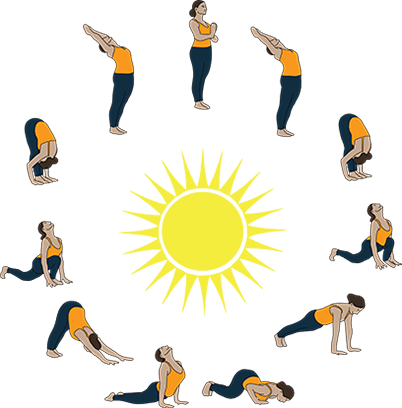On This Page
Surya Namaskar (Sun Salutation): A Stepping Stone to Transform Your Body
Introduction
On earth there is no life without the sun, so we can say that every day our life begins with the sunrise. In Various cultures, the Sun is considered a God and worshiped like Apollo in Greek, Mithras in Persian, Surya in India, Osiris in Egyptian, etc. In Hindu’s great Book Ramayana, Sage Agastya advised lord Rama to worship Surya for victory over the demon King Ravana. Surya (sun) is considered the ultimate power visible to the eye (Pratayaksha Swarupa) which represents the manifestation of knowledge, and truth, the giver of prosperity and intellect. Surya Namaskar is considered both spiritual as well as physical practice. Surya Namaskar also known as sun salutation, is a set of dynamic postures that is a complete physical exercise but is neither considered under traditional Yoga nor a part of Asana. This powerful sun salutation helps to connect with the frequencies of the cosmos, inner selves, etc. Regular practice of Surya Namskara gives various benefits to the respiratory, digestive, nervous, urinary, and circulatory systems, etc. By stretching and compression of muscles, the most benefited organs from Sun salutation are the spinal cord, lungs, throat, backbone, intestine, stomach, skin, etc. with regular practice of Surya Namaskar every cell, and tissue of the body revitalizes and regenerates, thus keep the body and mind healthy. In Surya Namaskar 12 Asanas are done and for each Asana one Mantra is mentioned that is chanted to worship the sun. Today Surya Namskara is becoming famous all over the world so let’s find out the interesting facts about the Sun salutation (Surya Namaskar).
Origin of Surya Namskara
Surya Namaskar is considered neither a Traditional Yoga nor an Asana. Surya Namaskar (Sun salutes) is considered a complete physical exercise that is believed to be propagated by the king of Aundh, Late Shrimant Balasaheb Pant Pratinidhi in the 1920s and later by Sri K V Iyer, and Sri Krishnam Acharya. In Vyayama Dipika, the Danda exercises were explained by Shri Krishnam Acharaya, which were found to be the basis of the model of Surya Namaskar. Danda exercise is a common practice used by wrestlers and martial artists. Both the Danda exercise and Surya Namskara show similarities, therefore Surya Namskara is the traditional blend of the practice of two systems Yoga and physical culture.
In Vedas:
The sanctity of the Sun is explained in Taittriyaka Aranyaka under Krishna Yajur Veda in 132 Verses.
In various parts of Vedas, it consists of hymns, formulas, spells, etc and in various parts, Surya (sun) is praised. In Various places saluting to the sun i.e Surya Namskara by magic means of the fire ritual is given for health and prosperity. The Virabhadrasana (ecstatic warrior posture) in the Surya Namaskar may be a reference to Vedic symbolism. (The Vedic corpus- 12th – 10th centuries BCE)
From Vedic times to the present day, Surya is worshiped throughout Asia. Even In Europe and Mesopotamia, worship of the sun disk is done as a deity. In Vedas seven Rigvedic guarding deities are mentioned in which one is named Mitra. Mitra is the Vedic personification of the Sun (Surya).
In Vedic literature, two forms of Surya Namaskar were mentioned:
- Trucha Kalpa Namskara
- Aditya Prasna
Trucha Kalpa Namskara:
This Namaskar was practiced in several regions of the Indian subcontinent. Trucha Kalpa Namskara has its roots in Rig Veda. In Veda, each Mantra is known as Rucha i.e hymn or verse. A combination of three hymns (Rucha) forms the Trucha Kalpa Namskara prayer.
Trucha Kalpa Namskara has three parts:
Sankalpa: In this Trucha Kalpa, at the beginning of Surya Namskara one makes a resolve and requests Lord Sun (Surya) to give them well-being and good health.
Dhyana Mantra: After making the resolution in Sankalpa part, Dhyana Mantra is recited i.e is mentioned below:
ॐ ध्यये सदा सवित्र मंडल मध्यवर्ती |
नारायण सरसिजसनसन्निविष्ट:
केयूरवन मकरकुण्डलवान किरीटी।
हारी हिरण्मय वपु: धृतशंखचक्रः। ।
Surya Namaskar: Lastly while reciting several Mantras, Surya Namskara is performed. All Mantras related to Surya Namskara should be recited in the correct order. The Mantra of Surya Namskara consists of three Ruchas that are mentioned in Ist Mandal, 9th Anuvak, 50th Sukta of Rig Veda, and is composed in Anushtup Chandas. Rucha of Surya Namskar are as follows:
उद्यन नद्य मित्रमह: आरोहन नुत्तराम दिवम |
हद्रोगम मम सूर्य हरिमाणम् च नाशय ||
Sukesume harimanam ropanakasu dadhmasi |
Atho hari dravesume harimanam ni dadhmasi ||
Udaghadayamadityo visvena sadasa suha |
Dvisantam mayhem Randhyan mo aham dvisate radham ||
Aditya Prasna
Aditya Prasana is most popular in Southern parts of India. Verses used in Aditya Prasana are mentioned in the first chapter of Yajurveda, Taittiriya. This chapter is also known as the Sun salutation chapter, and it has 132 Anuvakas. In Aditya Prasana after the recitation of every Anuvaka, Surya Namaskar (Sun salutation) is performed. According to Yajur Veda, if Surya Namskara hymns are practiced regularly then one can get freedom from health ailments and diseases.
Ancient origin of Surya Namskara (In Ramayana)
Two ancient origins were found in the Ramayana:
- In Yudh Khanda Canto 107 of Ramayana, the Sun salutation (Surya Namaskar) is mentioned as Aditya Hridyam, before starting a new day. It was taught before fighting with Ravana to Sri Rama Sage Agastya. In Aditya Hridyam Strotam, a total of 124 praises of the sun were mentioned. As per Purana, the regular practice of Sun salutation blesses humans with divine grace and good health.
- Guru Sishya’s relationship lies at the heart of Yoga. In ancient times student and teacher relationship is priceless. When Shishya (student) completed his study, he owed his Guru (teacher) a leaving fee i.e known as Guru Dakshina. In Yoga Sutra Chapter one verses 24- 26 Ishvara is considered the primordial Guru and here Ishwara is the high state of consciousness, not an individual. Surya “the sun” is one the most enduring symbol of a teacher as Sun is the one who illuminates our minds. The great monkey hero of Ramayana i.e Lord Hanuman was fascinated by Sun (Surya) since birth. As per the mythological story, Hanumana as a baby mistook the sun in the sky as big growing luscious mango. Hanumana as a baby leaped and soared to seize the sun and popped the sun into their mouth and began to eat it. Lord Indra hurled his Vajra on Hanuman’s jaw then he dropped the sun. In the meantime, Hanumana needed education and for that a good teacher. When Hanumana asked Surya to be his teacher, he refused. Surya said that he has no spare time as his schedule is strict. Surya said how can you learn from me when I’m moving all the time. Then Lord Hanuman said what if I keep up moving with you. Lord Surya said you won’t be able to but if you can then you can be my student. Then Lord Hanuman flew up and positioned himself in such a way that he faces Surya. Naturally, this also meant that Lord Hanuman was always traveling backward with his face to his Guru. Hanuman’s backward moving trajectory was considered the origin of the Surya Namskara i.e sun salutes. On mastering the study, Lord Hanuman asks about the Guru Dakshina. Then Lord Sun said that watching devoted students was the Guru Dakshina. Then Hanumana only offers his Namskara to the Sun. So, Surya Namskara was considered the Hanuman’s Guru Dakshina to Surya (sun).
Steps in Surya Namskara
As we know that Surya Namskara is the traditional blend of Yoga and physical culture. Today various versions of Surya Namskara are available. The simplified version of Surya Namskara is used by BSY (Bihar School of Yoga), and Swami Vivekananda Yoga Anusandhana Samsthana (SVYAS).
12 postures or steps mentioned in Surya Namaskar by Bihar School of Yoga as follows:
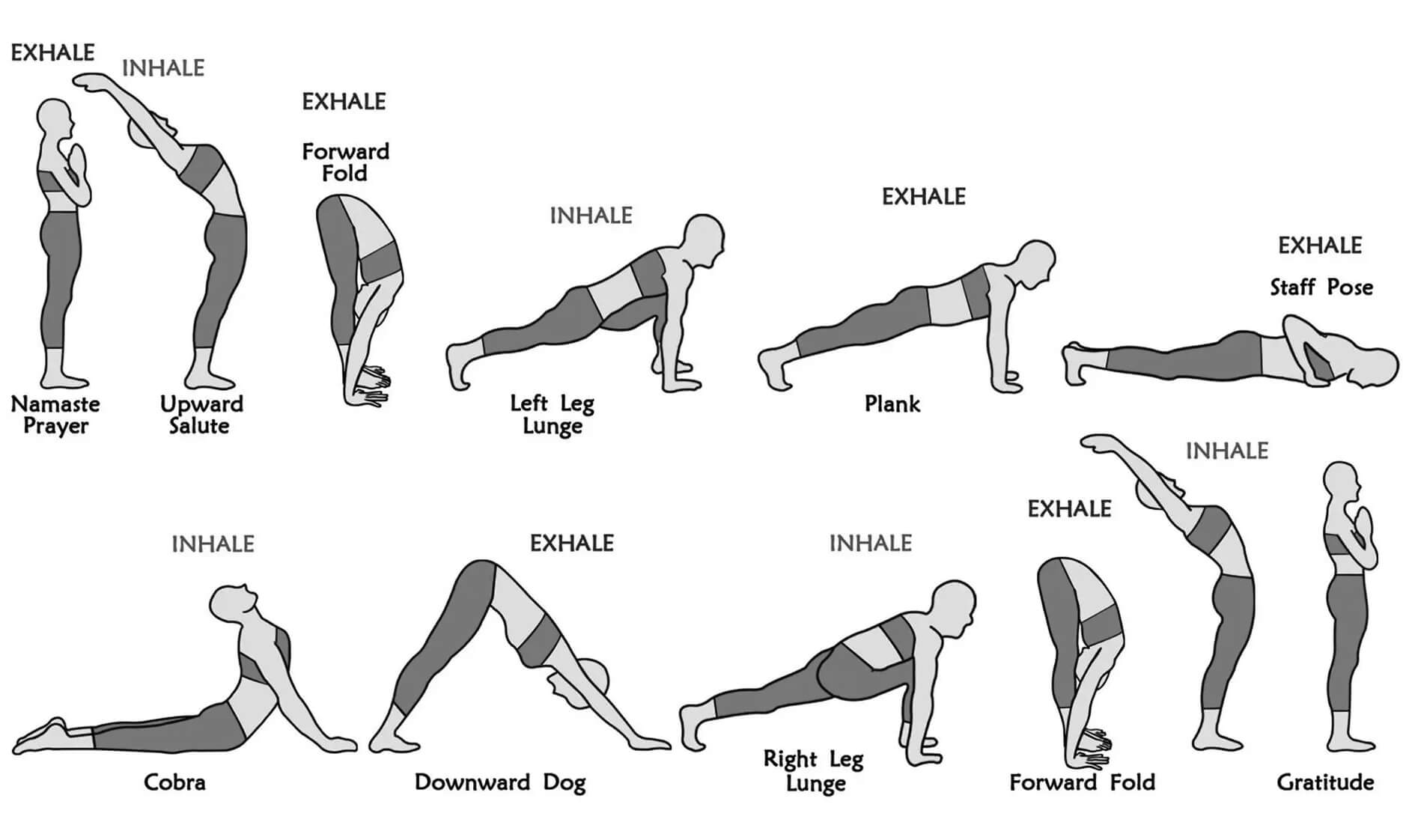
- Step 1: Pranamasana (prayer pose)
- Step 2: Hasta Utthanasana (raised arms pose)
- Step 3: Padahastasana (hand-to-foot pose)
- Step 4: Ashwa Sanchalanasana (equestrian pose)
- Step 5: Parvatasana (mountain pose)
- Step 6: Ashtanga Namaskara (salute with eight parts or points)
- Step 7: Bhujangasana (cobra pose)
- Step 8: Parvatasana (mountain pose)
- Step 9: Ashwa Sanchalanasana (equestrian pose)
- Step 10: Padahastasana (hand-to-foot pose)
- Step 11: Hasta Utthanasana (raised arms pose)
- Step 12: Pranamasana (prayer pose)
Way to perform 12 steps of Surya Namaskar in BSY tradition
In BSY tradition i.e., Bihar School of Yoga tradition, the 12 steps of Surya Namaskar consist of 5 postures i.e.
- 2 forward bending postures
- 3 backward bending postures
- To complete one round of Surya Namaskar, the postures are repeated except Ashwa Sanchalanasana (equestrian pose), which is done with the opposite side of the body part i.e., left or right in the second half.
The breathing pattern of different steps of Surya Namaskar:
Step 1: Step one starts with normal breathing.
Steps 2, 4, 7, 9, 11: The practitioner inhales with chest expansion during backward stretching.
Steps 3, 5, 8, 10, 12: The chest is contracted during forward bending and the breath is exhaled.
Step 6: In Step 6, the chest area is in contact with the floor, and no movement of air is possible, so the breath is held out i.e., Kumbhaka is performed.

Have A Health Issue?
Consult Online
- Dr. Sahil Gupta (B.A.M.S., M.H.A.)
Ayurvedic Allergy Specialist
CEO & Founder of IAFA®
Posture or steps mentioned in Surya Samskara by the different schools of Yoga
Tradition 1: Shivananda Yoga Vedanta center tradition
In this series of Surya Namaskara few postures are changed. The posture that is changed is as follows:
Step 5: In BSY in step 5, Parvata Asana (mountain pose) is mentioned but in Shivananda Yoga Tradition, Phalaka Asana is mentioned. In this step, breathing is held is Kumbhaka is performed.
Step 8: In BSY in step 8, Parvata Asana is mentioned, and this is named Adho Mukha Shav Asana in Shivanada Yoga Tradition.
Except for the above-mentioned changes, the rest of the postures are similar, and the pattern of breathing is similar to BSY.
Tradition 2: Krishna Acharya Vinyasa Yoga Tradition:
- In Krishna Acharya Vinyasa Yoga tradition, instead of twelve, 13 postures are mentioned.
- The first step/ Vinyasa (posture) is Pranama Asana or Samsthiti Asana after which Hasta Uttanasana or Tada Asana is performed.
- This Asana is followed by Pada Hasta Asana or Uttana Asana and Utkatasana i.s known as hip stretch pose.
- Then the practitioner does Chaturanga Asana by lifting the heels and jumping and landing on big toes.
- Then Danda Samrpana is done which is very similar to Ashtanga Namaskar.
- From this Vinyasa again Chaturanga Dandasana is performed followed by Urdhva Mukha Asana i.e very similar to Bhujangasana.
- Then Adho Mukha Svanasana i.e similar to Parvata Asana is performed followed by Utkatasana, Uttana Asana, Tada Asana, and Pranama Asana.
Breathing pattern in Krishna Acharya Yoga Tradition
- In Krishna Acharya Yoga tradition, during Surya Namaskar, the correct breathing pattern and chanting of mantras are strictly emphasized.
- In the First step i.e Namaskar Asana, the Yogi starts with inhalation and holding the breathing, and focus is maintained on the first Mantra.
- After holding the breath, inhalation is done smoothly, and Tada Asana is performed by raising the arms. During Chanting the Mantra of the second step again breathing is held.
- After that exhalation is done while achieving Pada Hastasana, inhale, and after that exhale during Utkatasana by bending the knees.
- There is one general rule of holding your breath in every posture when chanting the Mantra.
- While lifting the heels till landing on Chaturanga Dandasana, the practitioner inhales and holds their breath.
- In Chaturanga Danda Asana Yogi exhales and breathe is held then again slowly exhales while changing posture from Chaturanga Danda Asana to Danda Samarpana
Tradition 3: Swami Vivekananda Kendra Tradition
In Swami Vivekananda Kendra tradition, 12 postures or Vinyasa are mentioned similar to BSY.
Step 1: Hasta Uttanasana
Step 2: Panda Hatha Asana
Step 3: Ashwa Sanchalanasana
Step 4: Phalaka Asana or Danda Asana
Step 5: Shashanka Asana
Step 6: Sashtanga Namaskar (In this step of Surya Namaskar, eight parts of the body touch the floor).
Step 7 and Step 8 are similar to BSY i.e
- Step 7: Bhujangasana (cobra pose)
- Step 8: Parvatasana (mountain pose)
Step 9: Shashanka Asana
Step 10: Ashwa Sanchalana Asana
Step 11: Pada Hasta Asana
Step 12: Pranama Asana
Breathing pattern:
- In Phalakasana i.e Step 4 Yogi exhales and in Shashanka Asana i.e step 5, step 9 Yogi inhales while going in a backward direction and then exhales when achieving a final position.
- Except for the breathing pattern mentioned above, the breathing pattern of all other postures mentioned in the Swami Vivekananda Kendra tradition is similar to BSY.
Surya Namskara Mantra and Beeja Mantras
| Posture | Mantra | Mantra | Beej Mantra |
| Posture 1 | Om Hram Mitraya Namah | ॐ मित्राय नमः | Om Hram |
| Posture 2 | Om Hrim Ravaye Namah | ॐ रवये नमः | Om Hrim |
| Posture 3 | Om Hrum Suryaya Namah | ॐ सूर्याय नमः | Om Hrum |
| Posture 4 | Om Hraim Bhanave Namah | ॐ भानवे नमः | Om Hraim |
| Posture 5 | Om Hraum Khagaya Namah | ॐ खगाय नमः | Om Hraum |
| Posture 6 | Om Hrah Pushne Namah | ॐ पूष्णे नमः | Om Hrah |
| Posture 7 | Om Hram Hiranyagarbhaya Namah | ॐ हिरण्यगर्भाय नमः | Om Hram |
| Posture 8 | Om Him Marichaye Namah | ॐ मरीचये नमः | Om Him |
| Posture 9 | Om Hrum Adityaya Namah | ॐ आदित्याय नमः | Om Hrum |
| Posture 10 | Om Hraim Savitre Namah | ॐ सवित्रे नमः | Om Hraim |
| Posture 11 | Om Hraum Arkaya Namah | ॐ अर्काय नमः | Om Hraum |
| Posture 12 | Om Hrah Bhaskaraya Namah | ॐ भास्कराय नमः & ॐ श्रीसवितृसूर्यनारायणाय नमः | Om Hrah |
Meanings of different names of the sun (Surya)
| Name | Meaning |
| Mitra | Friend |
| Ravi | Shining |
| Surya | Beautiful light |
| Bhanu | Brilliant |
| Khaga | Who moves in the sky |
| Pushna | Giver of strength |
| Hiranya Garbha | Golden centered |
| Marichi | Lord of the dawn |
| Aditya | Son of the Aditi |
| Savita | Beneficent |
| Arka | Energy |
| Bhaskara | Leading to enlightenment |
Chakra (plexus) position in Surya Namaskar along with their effects of Surya Namaskar on plexus (Chakra) as per BSY (Bihar school of Yoga)
| Steps of Surya Namshkara | Chakra (plexus) position |
| Step 1: Pranamasana (prayer pose) | Anahata (Heart) |
| Step 2: Hasta Utthanasana (raised arms pose) | Vishuddhi (Throat) |
| Step 3: Padahastasana (hand-to-foot pose) | Swadhisthana (Sacrum) |
| Step 4: Ashwa Sanchalanasana (equestrian pose) | Ajna (Third eye) |
| Step 5: Parvatasana (mountain pose) | Vishuddhi (Throat) |
| Step 6: Ashtanga Namaskara (salute with eight parts or points) | Manipura (Solar plexus) |
| Step 7: Bhujangasana (cobra pose) | Swadhisthana (Sacrum) |
| Step 8: Parvatasana (mountain pose) | Vishuddhi (Throat) |
| Step 9: Ashwa Sanchalanasana (equestrian pose) | Ajna (Third eye) |
| Step 10: Padahastasana (hand-to-foot pose) | Swadhisthana (Sacrum) |
| Step 11: Hasta Utthanasana (raised arms pose) | Vishuddhi (Throat) |
| Step 12: Pranamasana (prayer pose) | Anahata (Heart) |
Shata Chakra has a very positive effect on Surya Namshkara. Plexus i.e Chakra is located in the different parts of the body and is considered an energy source in our body.
Effect of Surya Namshkara on Shada Chakras
Muladhara Chakra
Location of Muladhara Chakra: Muladhara Chakra is located in the region between the urinal opening and the region between the anal opening.
Organs: Organs associated with or affected by Muladhara Chakra are the anal opening, hip joints, urinal opening, both legs, ovaries, and testes.
Surya Namshkara’s posture effects on Shada Chakra
- Namshkara Asana- Namshkara Asana hold in Mulabandha, and as a result, it exerts pressure on Muladhara Chakra.
- Hasta Pada Asana- Hasta Pada Asana hold in Mulabandha, and as a result, it exerts pressure on Muladhara Chakra.
- Uttana Asana- This Asana stretches on Muladhara Chakra.
- Adhomukha Shav Asana- This Asana stretches on Muladhara Chakra.
Swadhisthana Chakra
Location of Swadhisthana Chakra: Swadhsthana Chakra is located in the regions of the sacrum and pubic area.
Organs: Organs associated with or affected by Muladhara Chakra are the rectum, uterus, large intestine, prostate gland, urethra, and urinary bladder.
Surya Namshkara’s posture effect on Shada Chakra
- Uttana Asana- It creates pressure on Svadhisthana Asana.
- Adho Mukha Shava Asana- It creates pressure on Swadhisthana Asana.
- Ardha Bhujanaga Asana- It creates pressure on Swadhisthana Asana.
- Urdhava Hasta Asana- This Asana stretches on Swadhisthana Chakra.
- Bhujanga Asana- This Asana stretches on Swadhisthana Chakra.
Manipura Chakra
Location of Manipura Chakra: Manipura Chakra is located in the pelvic region and Naval region.
Organs: Organs associated with or affected by Manipura Chakra are the liver, spleen, small intestine, kidney, stomach, and gallbladder.
Surya Namshkara’s posture effects on Shada Chakra
- Uttana Asana- This Asana exerts pressure on Manipura Chakra.
- Adhomukha Shava Asana- This Asana exerts pressure on Manipura Chakra.
- Ashtangsthithi- This Asana exerts pressure on Manipura Chakra.
Anahata Chakra
Location of Anahata Chakra: Anahata Chakra is located in the thoracic vertebrae and the regions between the heart.
Organs: Organs associated with or affected by Manipura Chakra are the heart, large arteries, hands, lungs, and diaphragm.
Surya Namshkara’s posture effects on Shada Chakra
- Urdhava Hasta Asana- This Asana exerts a slight pressure on Anahata Chakra.
- Ardha Bhujanga Asana- This Asana exerts a slight pressure on Anahata Chakra.
- Bhujanga Asana- This Asana exerts stretch on Anahata Chakra.
- Ashtanga Sthithi- This Asana exerts a stretch on Anahata Chakra.
- Adhomukha Shava Asna- This Asana exerts pressure on Anahata Chakra.
- Hasta Pada Asana- This Asana exerts a slight pressure on Anahata Chakra.
Vishudha Chakra
Location of Vishudha Chakra: Vishudha Chakra is located in the regions between the larynx box and cervical vertebrae.
Organs: Organs associated with or affected by Vishudha Chakra are the thyroid, parathyroid, tonsils, salivary gland, trachea, throat, esophagus, and larynx.
Surya Namshkara’s posture effects on Shada Chakra
- Ashtanga Sthithi- This Asana exerts pressure on Vishuddha Chakra.
- Urdhava Hasta Asana- This Asana exerts a stretch on Vishuddha Chakra.
- Ardha Bhujanga Asana- This Asana exerts a stretch on Vishuddha Chakra.
- Bhujanga Asana- This Asana exerts a stretch on Vishuddha Chakra.
- Surya Namshkara mantra recitation causes vibration in Vishuddha Chakra.
Ajna Chakra
Location of Anahata Chakra: Ajna Chakra is located exactly between the eyebrows.
Organs: Organs associated with or affected by Ajna Chakra are the eyes, nose, ear, tongue, cerebrum, and cerebellum.
Surya Namshkara’s posture effects on Shada Chakra
- Uttana Asana- This Asana brings calmness to Ajna Chakra and helps direct blood supply to the brain.
- Adho Mukha Shava Asana- This Asana brings calmness to Ajna Chakra and helps direct blood supply to the brain.
- Ashtanga Sthiti- This Asana brings calmness to Ajna Chakra and helps direct blood supply to the brain.
- Namshkara Sthiti- This Asana gives a high energy level to Ajna Chakra.
- Urdhava Hasta Asana- This Asana gives a high energy level to Ajna Chakra.
- Ardha Bhujanga Asana- This Asana gives a high energy level to Ajna Chakra.
- Bhujanga Asana- This Asana gives a high energy level to Ajna Chakra.
Shastra Chakra
Location of Shastra Chakra: The shallow part of the head and crown of the head.
When pressure and stretch are exerted on the Shada Chakra or six plexus of the body it helps in the efficient supply of pure blood to the specific organ affected by it and balances mind and body which as result helps in controlling Shastra Chakra,
Steps in Surya Namskara
Step 1: Pranamasana (prayer pose)
- Stand erect with your feet together.
- Face the sun or the direction of the sun.
- Place the two palms together in front of the chest in an attitude of prayer, the Namaskar Mudra.
- Close your eyes and relax your whole body.
- Be aware of the body for at least half a minute.
- This will prepare you for the forthcoming practice.
- Consciously try to relax the muscles of the body (Sharira).
Breathing: Breath normally with full awareness.
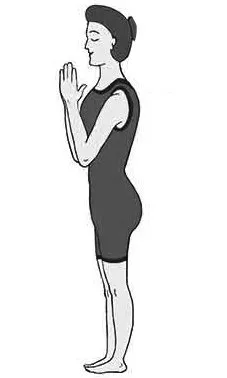
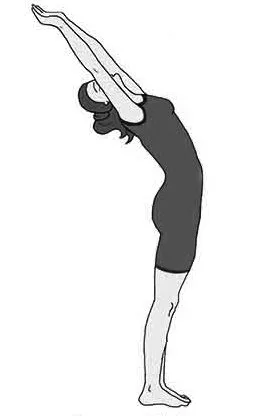
Step 2: Hasta Utthana Asana (raised arms pose)
- In Hasta Utthana Asana first, raise both arms above the head (Shira). During this step keep hands separated by a shoulder’s width.
- At the end of the movement bend the Shira (head), Bahu (arms), and upper trunk backward.
- The Hatheli (palms) should face forwards.
- The movement should be executed in one smooth motion with awareness.
Breathing: Inhale while raising the arms.
Step 3: Padahastasana (hand-to-foot pose)
- In Pada Hasta Asana, bend forward and place the palms of the Hasta (hands) on the floor, either on each side of the feet or in the front of the feet.
- The movement should be continuous and without any jerking.
- Keep the legs straight. If possible, try to touch your knees with your forehead or chin (be careful of your nose for you may cause injury when doing Surya Namaskar quickly).
- In order to attain the final position, no undue forces should be used under any circumstances.
Breathing: In step 3 i.e. Pada Hasta Asana, exhale as deeply as possible while bending forwards. If possible, accentuate the contraction of the abdomen, especially in the final position.
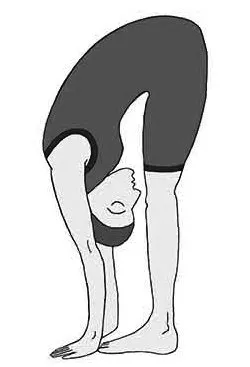
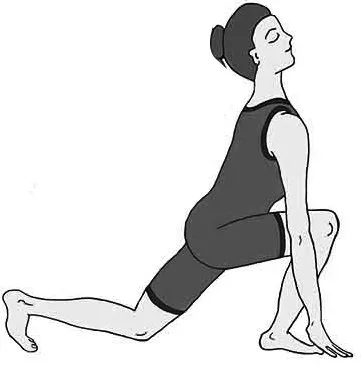
Step 4: Ashwa Sanchalanasana (equestrian pose)
- Stretch the right leg back as far as you can.
- In Ashwa Sanchalan Asana, simultaneously bend the left leg at the Jaanu (knee) but keep the left foot in the same position.
- The palms should remain on the floor and the arms should remain straight.
- For beginners, if this step is difficult then palms can be raised off the ground, with only the fingertips in contact with the floor. This change in steps helps to increase the arch of the back.
- In the final position, the toes and Jaanu (knee) of the extended right leg should be in contact with the ground.
- Complete the movement in Ashwa Sanchalana by bending the head backward and arching the spine as much as possible without straining.
- The movement should be executed smoothly and with awareness.
Breathing: In this step, inhalation is done.
Step 5: Parvatasana (mountain pose)
- Raise your right knee.
- Side by side lower your Shira (head) towards the floor and bend the back so that the buttocks move upwards.
- Stretch the left leg backward and place the left foot beside the right foot.
- Then raise the buttocks as high as possible into the air.
- After that, lower the head so that it lies between the two arms (Bahu).
- The legs should be straightened in the final position.
- Try to press the heels of both feet toward the ground.
- Throughout the practice of Parvata Asana, the Bahu (arms) must remain straight, and the Hasta (hands) and right foot should remain in contact with the floor.
Breathing: Exhale deeply as you perform the movement.
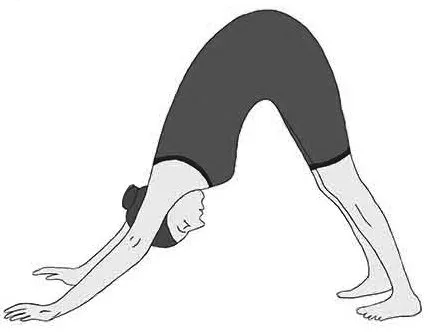

Step 6: Ashtanga Namaskar (worship with eight points)
- This step is called Ashtanga Namaskar because in the posture eight points of the body are in contact with the floor.
- Lower the body to the ground, first bending the legs and placing the knees in contact with the floor.
- After that bend, your arms, lower the head and trunk towards the floor.
- Try to brush your forehead along the surface of the floor as you move the head and trunk forwards.
- At the end of the forward movement of the head and trunk, let the chest brush along the surface of the floor and rest the chin on the ground.
- Finally, raise the abdomen and hips slightly off the ground.
- In the final position, the eight points should be on the ground: the chin, the chest, two palms, two knees, and the balls of both feet.
- The whole movement should be smoothly executed.
Breathing: Hold the breath outside, i.e., don’t breathe in. (Kumbhaka)
Step 7: Bhujangasana (cobra pose)
- Lower the hips to the ground.
- Side by side in this posture, straighten the arms so that the head and back arch upwards.
- In the final position, the Shira (head) and Pristha (back) should be bent backward as far as is comfortable.
- Without straining, try to keep the abdomen as close as possible to the ground.
- The position of the Hast (hands) and Paad (feet) should not change throughout the movement.
Breathing: Inhale deeply during the movement.
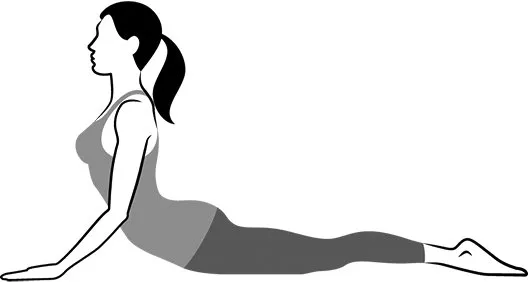
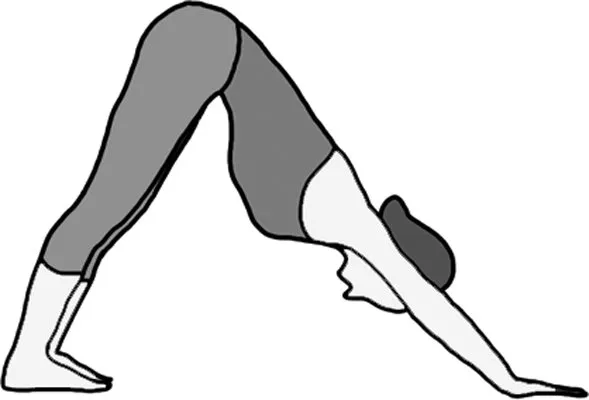
Step 8: Parvatasana (mountain pose)
- This position is a repeat of position 5.
- From the arched position of Bhujangasana, in Parvata Asana bend the back in the opposite direction so that the buttocks move upwards.
- Keep the Hasta (arms) and legs straight.
- Don’t move the position of the hands and feet.
- In the final pose, the buttocks should be as high as possible, the head should be between the arms and the heels should be gently pressed toward the floor.
Breathing: Exhale while performing the movement.
Step 9: Ashwa Sanchalanasana (equestrian pose)
- This position is a repeat of position 4.
- Bend the left leg and place the left foot between the two hands.
- Side by side raise the head upwards, arch the back downwards and lower the right knee to the floor.
- The position of the two hands and the right foot must not change.
- The arms should remain straight throughout.
- In the final pose, accentuate the arching of their back and bend the head backward as far as possible.
Breathing: Inhale deeply in this pose.
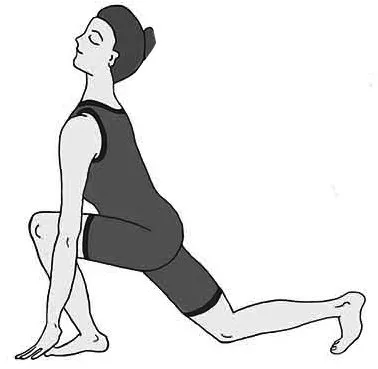
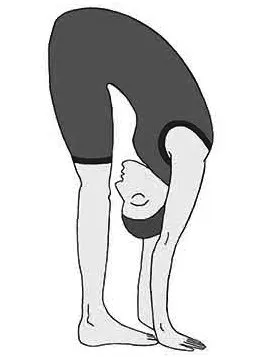
Step 10: Padahastasana (hand-to-foot pose)
- This position is the same as position 3.
- Lower the head towards the ground.
- Simultaneously raise the buttocks and right knee upwards.
- Place the right foot beside the left foot in between the hands in this step.
- Straighten the legs and try to touch the forehead to the Jaanu (knees).
Breathing: As you move the head towards the knees, exhale in this posture.
Step 11: Hasta Utthanasana (raised arms pose)
- This position is the same as position 2.
- Smoothly straighten the whole body.
- In Hasta, Uttana Asana keeps the Baahu (arms) straight and separated by about a shoulder’s width.
- Raise the arms over the head and lean the head, arms, and back slightly backward.
- To do this the abdomen must be pushed a little forward.
Breathing: Inhale throughout the movement.
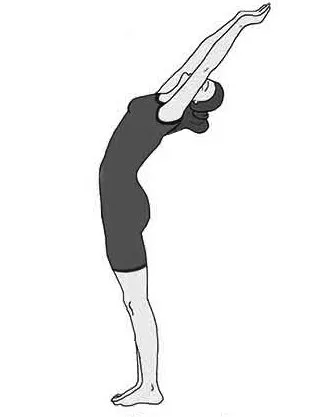
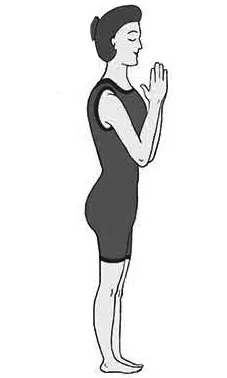
Step 12: Pranamasana (prayer pose)
- This posture is the same as position 1.
- Bring the palms together.
- Hold them in front of the chest.
- Relax the whole body.
- Breathing: Exhale while assuming the final pose.
Breathing: First exhale and then before continuing the practice, breathe normally while remaining in the final position.
Warm-up before Surya Namaskar
Surya Namaskar is itself considered a warm-up for the practice of various Asana. The yoga teacher will introduce Surya Namaskar as a precursor to their student before performing more challenging Asana.
But if you are suffering from any kind of tension, then before starting the Surya Namaskar you can stretch your body, especially when you are doing Surya Namaskar in the morning.
General benefits of Surya Namaskar
- As we know that the ideal time to perform Surya Namaskar is early sunrise. During this ideal time, UV light is not very harsh, as a result, skin is not overexposed to the sun. When Surya Namaskar is performed at this time it provides Vitamin D from the rich source of the sun and also helps to clear the vision.
- Surya Namaskar when performed, it activates the Pingla Nadi of the body i.e. Surya Nadi, which as a result provides a high level of positive energy to the body.
- Surya Namaskar when done regularly for the prescribed period then helps in losing unwanted body flab as it acts as a complete bodywork out.
- A recent study proves that Surya Namaskar activates fat metabolism, and normalizes the hormones in the body. Therefore, it helps to lose weight and helps to treat obesity.
- Surya Namaskar helps to increase the flexibility of the joints and thus makes joints of the body strong and healthy.
- Surya Namaskar helps to restore lost elasticity through the stimulation of glands. It helps in stimulating the breast and helps in maintaining its firmness.
- Surya Namaskar helps to regularize the menstrual cycle and helps in PCOD, and various gynecological disorders. It also makes childbirth easier.
- Surya Namaskar strengthens the pectoral muscles and gives stamina and strength to lactating mothers while breastfeeding.
- It removes the early sign of aging like wrinkles, hyperpigmentation, etc., and gives a radiant glow to the skin.
Effects on Surya Namaskar in a different system of the body
- On Gastrointestinal system: When we do different postures of Surya Namshkara, the stomach and abdominal organs are alternately stretched and compressed. Due to this stretch and compression in the organs, it imparts a healthy massage to them and ensures that they function correctly physiologically, or if they don’t currently work efficiently, this massage with time encourages them to do so. Many diseases of the digestive system like constipation, diarrhea, ulcerative colitis, Crohn’s disease, IBS, etc. can be prevented and treated permanently by the regular practice of Surya Namaskar.
- On eliminative system: Mala Nisarga (Rapid elimination) is our body is very essential. Due to Vivandha (Constipation), Apachana (indigestion), etc often undigested waste products remain in the Aantra (intestines) and bowels which can result in various other gastrointestinal disorders. By doing the different postures of Surya Namaskar, we can stimulate the peristalsis of the Aantra (intestines) helping to remove any tendency towards Vivandha (constipation). Surya Namaskar also affects the kidneys, which are also important eliminative organs. They filter impurities from the blood and eliminate them from the body in the form of urine.
- Skin –A high proportion of the Aam (body’s waste products/ toxins) are eliminated through the Tvaka (skin). This process of removing toxins from the skin works particularly well when a person sweats (Swedana) profusely. Often toxins accumulate in the skin, manifesting as Mukha Dushika, and Vrana (boils and pimples). If a good Swedana (sweat) was developed regularly there would be fewer tendencies for this to happen as the Aam (toxins) would reach the outer surface of the Tvaka (skin) and be washed off. Surya Namaskara results in increased Swedana (perspiration) and thereby encourages the elimination of toxins from the body, helping to prevent various Kustha Vikara (skin ailments).
- Circulatory system: When we do different postures of Surya Namaskara, it increases the Hridya Gati (heartbeat) and the workings of the whole circulatory system, helping to eliminate waste materials from the body. When Surya Namshkara is done properly and regularly it results in the removal of areas of sluggish blood and they are also replaced by purified and oxygenated blood. All the cells of the body receive extra nutrition enabling them to function more efficiently. This leads to better circulatory health and increased vitality of Yogis. The lymphatic system is also speeded up. This system is most important in protecting the body against infection.
- Respiratory system: Most people tend to breathe superficially in short and shallow gasps. Doing this results in starvation of the body for the oxygen it requires for good health. This also results in carbon dioxide accumulation in the respiratory system. Further underutilization of the lung capacity allows a buildup of germs which can lead to various illnesses. Surya Namaskar, when done correctly, accentuates the exchange of air to and from the lungs, opens and expands the intricate alveoli, or air sacs, of the lung tissue, and exercises the muscles of the surrounding chest region. Surya Namshkara results in an extra supply of oxygen which in result revitalizes the body and the brain as the lungs are emptied of impurities and stale air. One can almost feel the Prana Shakti (extra supercharge of energy).
- Hormones stimulator: Different posture of Surya Namaskar helps to stimulate various hormone-related glands like the pituitary gland, adrenal gland, etc. This stimulation of glands results in the proper secretion of growth hormones. Surya Namaskar also helps to stimulate the thyroid gland which as result helps to regulate the Menstrual cycle.
- Nervous system: While doing Surya Namaskar 12 steps, multitudes of Nadi (nerve) connections throughout the body are gently stretched, massaged, and stimulated. As we know that nerves are the functional unit that connects the different parts and organs of the body with the brain. The nerves are the intermediates and even if an organ is in perfect condition, it can only function properly if the Nadi (nerves) associated with it is healthy and will allow it. If the Nadi (nerves) are unhealthy then the function of the associated organs must suffer from dysfunction which results in various Vyadhis (disorders).
- Muscles and skeleton system: 12 steps of Surya Namaskara exercise all the main Maash Peshi (muscles) and Sandhi (joints) in the body. By doing Surya Namshkara, muscles are Sankuchit and Prasarit (contracted and extended), and any impure, stagnant blood is redirected back to the lungs and kidneys for purification.
Effect of Surya Namaskar on various bio- chemical parameters
- It helps to reduce fasting BSL
- Reduce postprandial BSL
- Stimulates insulin production
- Reduces oxidative stress
- Improves lipid profile
- Reduces waist and hip ratio
- Decreases CRP level in the body
Mental benefits of Surya Namaskar
- The mental benefits of Surya Namaskar are the same as meditation.
- Surya Namaskar increases serotonin neurotransmitters in the body, thus increasing the good mood of the individual.
- Reduce cortical in the body, therefore as a result reduce stress, anxiety, and depression.
- Maintaining a healthy mind and body coordination which is very beneficial, especially in old age.
- Increase concentration and mental focus.
Reason to adopt Surya Namaskar in daily life
- Surya Namaskar can be practiced by anyone, anywhere, anytime.
- In a busy lifestyle, it will not take you much time, just 3 to 10 minutes are enough.
- If we practice some particular Asana, then it only affects the particular organ or part of the body but Surya Namshkara practice will affect the entire body.
- No props or equipment required for doing Surya Namshkara.
- By stretching and compressing the abdominal region, Surya Namshkara will tone up the abdominal region.
- It massages the viscera i.e Yakruta (liver), Aamashya (stomach), Pleeha (spleen), Aantra (intestines), and Vrikka (kidney).
- Surya Namaskar will thoroughly ventilate the Phupphus (lungs), synchronize the movements of breathing, and oxygenate the blood. It also helps the body to get rid of toxic gasses, carbon dioxide, etc.
- Surya Namaskar will increase the Rakta Parvaha (blood flow) and increase cardiac activity. It also helps to warm the extremities.
- Surya Namaskar helps to stretch and bend the spinal column and tones up the nervous system.
- It is very beneficial for people suffering from Anidra (insomnia), as its regular practice helps to promote good sleep.
- As it increases blood flow to the brain, and therefore helps to improve memory.
- Surya Namaskar helps to calm Chintan (anxiety).
- Surya Namaskar’s posture by compression and decompression of Greeva (Neck) helps to stimulate and normalize endocrine glands, and the thyroid gland.
- Surya Namaskar by increasing perspiration helps to clear the complexion and refresh the skin.
- Surya Namaskar has a great impact on the reproductive system, it controls the activities of the uterus and ovaries thus helping to cure various problems related to menstruation, conceiving, and also assisting in childbirth.
- For obese people and people who want to lose fat or want to decrease weight, Surya Namaskar is a boon.
Best time to perform Surya Namaskar
EARLY SUNRISE, EMPTY STOMACH
As per Ayurvedic classical literature, before the sunrise the body is in the Vata phase, and after sunrise, the body moves to the Kapha phase from the Vata phase. So, if Surya Namshkar is done in the early sunrise, the connection is maintained between the airy movements of Vata and sluggish Kapha which activates the fire of Pitta. Thus, Surya Namshkar brings all three Dosha into play which as result brings optimal health.
The scientific aspect of Surya Namaskar
As we know the best time to perform Surya Namaskar is early sunrise, At that time sun ray affects the human body in three ways:
- By Photo- chemical energy
- By heating or a thermal effect
- By photosynthesis
When Ultraviolet light from sun rays strikes the skin of the human body:
- It increases calcium metabolism by profoundly increasing blood content towards Tvaka (skin).
- The disturbed chemical reaction in the body will be restored to normal chemical reactions.
- The bacteria that are harmful to the human skin are killed directly by the ultraviolet rays i.e., by increasing the systemic and local resistance.
- Ama (toxins) in the body is rendered inert.
Surya Namaskar (Sun salutation) – Syncing with the Universe
Calories and Surya Namaskar’s relationship
Each set of Surya Namaskar has 12 postures i.e Asana. If the practitioner performed one set of Surya Namaskar the approximate 13. 90 calories are burned. When Surya Namaskar is performed 12 times i.e 12 set of Surya Namaskar is done the 288 Asana one can get done. These 288 Asana is done in just 20 minutes. So, from here we can assume how much effective is Surya Namaskar for calorie burn.
Who should not perform Surya Namshkara?
- Pregnant women
- Patients with hernia
- Patients with hypertension (high blood pressure)
- People suffering from backache will do Surya Namaskar after seeking proper advice.
- Avoid Surya Namaskar during menstruation.
- If suffering from a wrist injury.
Precautions while doing Surya Namaskar
Surya Namaskar is a powerful method of eliminating toxins from the body. However, these toxins should not be eliminated too quickly, for they may manifest in several uncomfortable ways, such as huge painful boils. If any such symptoms or sign of fever begins to show, reduce the number of rounds of Surya Namaskar or even stop altogether for a few days. The toxins must be eliminated from the body, but they should be done gradually over weeks or months, utilizing Surya Namaskar, Asanas, and Pranayama.
Comparison of Surya Namaskar calorie burn with some other exercises
| Work out | Calorie burnt |
| Tennis | 230 cal |
| Basketball | 266 cal |
| Weightlifting | 120 cal |
| Foot ball | 290 cal |
| Rock climbing | 363 cal |
| Running 7.5 mph | 411 cal |
| Cycling 14- 15 mph | 332 cal |
| Surya Namshkara | l |
Diseases management with Surya Namaskar (recent research and study)
Study 1:
Study – Bhutkar PMet al., 2008
Study design- Pilot (Observational) study
Population type/ size of the study group- MBBS students, 78
Intervention- Surya namaskar
Comparator- Pre- and post-practice comparison
Outcomes- Increases cardiorespiratory efficiency and lung capacity
Conclusion- Suggested as a practice for improving cardiovascular efficiency.
Study 2:
Study – Bhavanani ABet al., 2011
Study design- Comparative controlled study
Population type/ size of the study group- School children, 42
Intervention- Surya Namaskar Fast: 12 postures in 2 min
Slow: 30s hold in each posture, 12 postures in 6 min
The total duration was 6 months
Comparator- Comparison of Fast and slow Suryanamaskar
Outcomes- Positive physiological benefits evident from changes in pulmonary functions and resting cardiovascular parameters.
Conclusion- Effects of fast Surya Namaskar were similar to aerobic exercise while slow-paced was similar to yoga training. Introduction of Surya Namaskar in School children would improve their physical fitness.
Study 3:
Study –Bhutkar Met al., 2011
Study design- Sequential self-control study
Population type/ size of the study group- Healthy individuals, 79
Intervention- Omkar chanting, Surya Namaskar, Shavasana; 24 weeks Yoga Vidya Dham Tradition
Comparator- Pre and Post practice after 24 weeks
Outcomes- Significant decrease in BMI, significant increase in muscle strength and endurance, significant decrease in body fat percent only in females.
Conclusion- Surya Namaskar is an ideal exercise for an optimum level of fitness.
Study 4:
Study- Pal A et al.,2011
Study design- Randomized Controlled Trial
Population type/ size of the study group- Subjects with coronary artery disease, 170
Intervention- Jala Neti, Shavasana, Bhujangasana, Shashankasana, Vajrasana, Ushtrasana, Siddhasana, Hasta Uttanasana, Nadishodhan pranayama for 6 months Comparator- intervention group compared with the non- yogic group who underwent conventional treatment.
Outcomes- Significant reduction in blood pressure, heart rate, body fat percentage, total cholesterol, Triglycerides, and LDL after practice.
Conclusion- These practices will be beneficial for cardiac and hypertensive patients.
Study 5:
Study: Mody BS., 2011
Study design- Pilot (Observational) study
Population type/ size of the study group- Healthy Asian Indian Men and Women, 6
Intervention- Suryanamaskar for 30 min
Comparator- Heart rate and oxygen consumption were measured while performing 4 rounds of Surya namaskar in 30 min.
Outcomes- Average Intensity was 80% HRmax, oxygen consumption was 26 ml/ kg/ min, energy expenditure 230 kcals
Conclusion- Regular practice helps improve cardio-respiratory fitness and promote weight management.
Study 6:
Study- Nidhi R et al.,2012
Study design- Prospective, randomized interventional controlled trial.
Population type/ size of the study group- Adolescent females, 90
Intervention- Surya Namaskar, asanas, pranayama, and meditation for 1hr/ day for 12 weeks
Comparator- Yoga practitioners compared to the physical exercise group
Outcomes- Improvement in glucose, lipid, insulin, and insulin resistance independent of anthropometric changes
Conclusion- Yoga was found to be more effective than conventional physical exercise in adolescent girls with PCOS.
Study 7:
Study- Jakhotia Kaet al., 2015
Study design- Comparative controlled study
Population type/ size of the study group- Obese females, 119
Intervention- Surya Namaskar
Comparator- Comparison of circuit training (CT), treadmill walking, and modified Suryanamaskar (SN) with control.
Outcomes- All three methods were effective in weight and physical fitness management, SN and CT more effective in improving cardiorespiratory fitness and upper limb muscle endurance. Only SN was effective in improving body flexibility.
Conclusion-Compared to the other two methods Surya Namaskar showed better results in all parameters analyzed – such as weight management, cardiorespiratory fitness, and body flexibility.
Study 8:
Study- Paikkatt B et al., 2015
Study design- Randomized controlled trial
Population type/ size of the study group- Individuals with Chronic schizophrenia, 30
Intervention- Surya Namaskara, asanas, pranayama for 90 min/ day for 1 month.
Comparator- Comparison of yoga therapy with pharmacotherapy
Outcomes- After a 1-month yogic intervention group showed a better rating in Positive and Negative Syndrome Scale (PANSS) variables than the pharmacotherapy group.
Conclusion- Yoga practice improves psychopathology resulting in a better quality of life.
Study 9:
Study- Godse AS et al.,2015
Study design- Randomized controlled trial
Population type/ size of the study group- College students, 419
Intervention- Surya Namaskar for 14 days
Comparator- Experimental compared to the control group (non-yoga group)
Outcomes- Surya namaskar can be applied as a relaxation strategy for high-stress college students with high R disposition levels and to reduce stress at a dispositional level.
Conclusion- Surya Namaskar is effective in leading to Dispositional like physical relaxation, mental quiet, etc, and negative emotions at a dispositional level.
Study 10:
Study- Dhawan V et al.,2018
Study design- Controlled trial
Population type/ size of the study group- Men volunteers, 42
Intervention- Loosening practices, Surya Namaskar, asanas, pranayama, and meditation for 120 min for 21 days.
Comparator- Comparison between the start and end of yoga sessions after 21 days.
Outcomes- Significant reduction of reactive oxygen species levels, increase in sperm motility and sperm count, decrease in DNA fragmentation index post 21-day yoga sessions.
Conclusion- Yoga-based lifestyle intervention improves pregnancy outcomes and improves the health trajectory of the offspring.
Study 11:
Study- Muller Patan RP et al., 2019
Study design- Cross-sectional study
Population type/ size of the study group- Trained healthy yoga practitioners,10
Intervention- Surya Namaskar, 5 rounds; traditional school type and non-traditional school type.
Comparator- Joint angles of the spine and upper and lower extremities were computed.
Outcomes- Principal motion occurs in the sagittal plane and joint motion was mostly symmetrical in most of the poses.
Conclusion- Surya Namaskar holds the potential to increase the mobility of almost all joints.
Study12:
Study- Chatterjee Set al., 2021
Study design- Quasi Experimental research design and convenient sampling method
Population type/ size of the study group- Middle-aged Healthy volunteers, 86
Intervention- Kriya, Surya namaskar, asana, pranayama, and dhyana daily in the morning, for 6 days/ week, for 12 weeks.
Comparator- Standing height, body weight, body mass index, visual reaction time (RT), auditory RT (attention and alertness), and short-term memory were assessed on day 1 (pre), 6th week (mid), and 12th weeks (post) of intervention.
Outcomes- Significant increase in alertness- attention and short-term memory
Conclusion- Yogic intervention has promising effects on neurocognitive abilities and thereby promotes successful aging.
Recent research on Surya Namaskar
- Sachan, Anurag & Solanki, Geeta. (2021). Surya Namaskar: Its Techniques and Health Benefits. 12. 32393- 32396.
- Venkatesh, L. & Vandhana, S. (2021). Insights on Surya namaskar from its origin to application towards health. Journal of Ayurveda and Integrative Medicine. 13. 100530. 10. 1016/ j. jaim. 2021. 10. 002.
- Bhavanani AB, Udupa K, Madanmohan, Ravindra P. A comparative study of slow and fast Surya Namaskar on physiological function. Int J Yoga. 2011 Jul;4(2):71-6. doi: 10. 4103/ 0973- 6131. 85489. PMID: 22022125; PMCID: PMC 3193657.
- Stec K, Choudhary R, Kulmatycki L. The effects of dynamic Surya Namaskara on differential chest circumference of physical education students. Human Movement. 2010; 11 (2): 179- 183. 11.
- Chutia S, Changmai S, Thapa SK, Gogoi BC. Effect of Surya Namaskara on the flexibility of middle elementary school students. International Journal of Physical Education, Sports and Health 2016; 3 (4): 142- 143. Retrieved from www.kheljournal.com
- Deshmukh A, Chincholkar S, Sutar A, Godey S. A comparative study between Pilates and Surya Namaskara on flexibility in women having sedentary lifestyle using sit and reach test and shoulder and wrist test. International Journal of Yoga, Physiotherapy and Physical Education. 2018; 3 (2): 190- 195. Retrieved from www.sportsjournal.in
- Vaibhav A, Shukla S, Singh OP. Surya Namaskara (Sun Salutation): A Path to Good Health. International Journal of Pharmacological Research, IJPR, 2016; 6 (07). Retrieved from www.ssjournals.com
- Zala A. Effect of Surya Namaskara on Flexibility of Middle Elementary School Students. Aayushi International Interdisciplinary Research Journal (AIIRJ), 2019; VI (VI): 13- 15, Peer Review e-Journal Impact Factor 5.707 ISSN 2349- 638x. Retrieved from website: – www.aiirjournal.com
- Shankar G, Pancholi B. The Effect of Surya Namaskara Yoga Practice on the Heart Rate, Blood Pressure, Flexibility, and Upper Body Muscle Endurance in Healthy Adults. International Journal of Health Sciences and Research. 2011; 1 (1): Retrieved from www.ijhsr.org
- Singh R, Singh K. Effect of eight weeks training of Surya Namaskara on the flexibility of cricket players. International Journal of Applied Research. 2016; 2 (4): 665- 667 8. Singh AS, Singh V. Effect of Surya Namaskara on Static Balance of School Girls. International Journal of Physical Education, Health and Social Science (IJPEHSS), 2014; 3 (2).
- Paikkatt B., Singh A.R., Singh P.K., Jahan M., Ranjan J.K. Efficacy of Yoga therapy for the management of psychopathology of patients having chronic schizophrenia. Indian J Psychiatr. 2015; 57 (4): 355– 360.
- Godse A.S., Shejwal B.R., Godse A.A. Effects of Surya Namaskar on relaxation among college students with high stress in Pune, India. Int J Yoga. 2015; 8 (1): 15– 21.
- Bhavanani A.B., Ramanathan M., Balaji R., Pushpa D. Immediate effects of Suryanamaskar on reaction time and heart rate in female volunteers. Indian J Physiol Pharmacol. 2013; 57 (2): 199– 204.
- Potiaumpai M., Martins M.C., Rodriguez R., Mooney K., Signorile J.F. Differences in energy expenditure during high-speed versus standard-speed yoga: a randomized sequence crossover trial. Compl Ther Med. 2016; 29: 169– 174.
- Javadekar P and Manjunath NK. Effect of Surya Namaskara on sustained attention in school children. J Yoga Phys therapy.2012; 2: 110
- Ponmathi P, et al.Comparison of aerobic versus stretching exercise programs on pain and menstrual symptoms in subjects with primary dysmenorrhoea. J Women’s Health Care. 2016; 5: 327.
- Mody Br. Acute effects of Suryanamaskara on the cardiovascular and metabolic system. Journal of Bodywork and movement theopies.2011; 15 (3): 343- 7
- Sasi A, Sivapriya D, Thirumeni S. Effects of Surya namaskar on cardiovascular and respiratory parameters in school students. Recent Res Sci Tech. 22011; 3: 19- 24
- Kaduskar P, Suryanarayana KM. An endocrine therapy. Indian Journal of Endocrinology and Metabolism. 2015; 19 (3): 437- 8.
- Srivastav R, Hyanki D, Chaurasia P, Bhardwaj A. Effect of Surya Namaskar on Highly Sensitive C-Reactive Protein Levels in Overweight and Obese Middle-Aged Adults. Int J Clin Exp Physiol. 2020; 7 (1): 33- 5.
References
- Dr. Bargale Sushant Sukumar, Dr. Sashi Rekha H. K., A textbook of Swasthvritta, Edition ist 2016, Reprint, 2017, 2018, Chaukambha Publication New Delhi.
- Jan K. Brzezinski, Yoga Trangini, A rare commentary on Goraksha Samhita, Published by Himalayan Yoga publication trust, First edition, Delhi, 2015.
- B. K. S. Iyengar, Light on Pranayama.
- Swami Dwarika Nath Shastri, Hath Yoga Pradipika, reprint 2009, Chaukambha Vidya Bhavan.
- Acharya Shri Nivasa Sharma, Gherand Samhita, first edition 2006, Choukambha Vidya Bhavan.
- Venkatesh, L. & Vandhana, S. (2021). Insights on Surya namaskar from its origin to application towards health. Journal of Ayurveda and Integrative Medicine. 13. 100530. 10. 1016/ j. jaim. 2021. 10. 002.
- https://yogainternational.com/article/view/the-ancient-origins-of-surya-namaskar-sun-salutation
- https://emoha.com/blogs/fitness/origins-of-surya-namaskar-sun-salutation.
- Madanmohan, Bhavanani AB, Dayanidy G, Sanjay Z, Basavaraddi IV. Effect of yoga therapy on reaction time, biochemical parameters and wellness score of peri and post-menopausal diabetic patients. Int J Yoga. 2012 Jan; 5 (1): 10-5. doi: 10. 4103/ 0973- 6131. 91696. PMID: 22346060; PMCID: PMC 3276926.
- Kathane, Vikas & Vithalani, Lalitkumar & Dalvi, Sanjay. (2013). A Comprehensive Study on Effect of Surya Namaskar On Cardio-respiratory Endurance.

